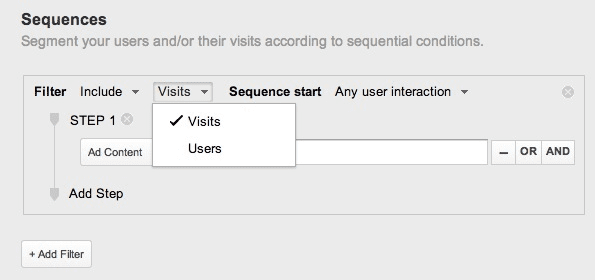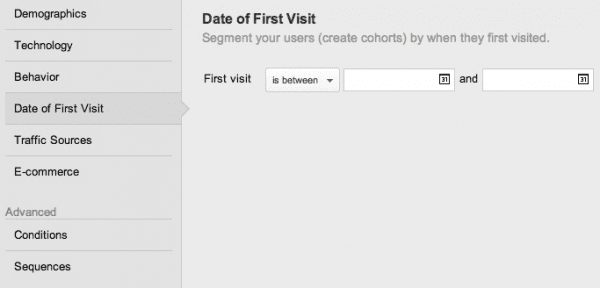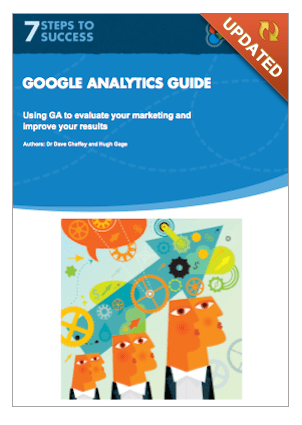A briefing on the new segmentation features for Google Analytics
Probably one of the most significant updates to be rolled out of Google analytics in recent times is the revamped segmentation feature, it is hard to understate its impact! In fact, when it was introduced Justin Cutroni of Google called it "one of the most important changes ever".
Leaving aside the dazzling new layout and looks there are three incredibly strong new features which bare mentioning, in no particular order of importance they are:
- the ability to segment by "users" (...for which, read visitors)
- the ability to build sequential segments
- the ability to create cohort segments.
Users
The first of these is pretty emblematic of all that's changing in the world of digital analytics. Until recently the base level metric underpinning all web analytics data was the humble visit, that's now being usurped by The Visitor or User.
The long term goal for all this is the ultimate aim of tracking non personally identifiable users across not only marketing acquisition channel but also platform (PC, tablet, mobile) and delivery channel (online, high street, telephone, mobile app, catalogue etc.)
Although it's already possible to track the visitor journey across platform, in reality until we get better at asking permission from our customers to do so, we'll have to settle for thinking of visitors and creating segments primarily in the context of a single device / channel based on multi session 'user' behaviour', and not (as before) always on behaviour that occurred within a single session.
But that's still an important part, by segmenting at the user level it's now possible to look at behaviour that spans more than one session or visit to a site, mobile site or app, in other words behaviour that more accurately (but not completely) reflects human beings.
Sequential segmentation
This is little short of epic. Years before it was available I would often ask myself and be asked by clients, 'If only it was (me) / is it (client) possible to look at people who did this and then did this....?', the key bit there being '...and then...'. Now with sequential segmentation it is.

Segments can be created at the visit level or the user level and filters applied using almost any combination of variables.
Of course the more prescriptive the segmented sequence of events, the smaller the segment size will be meaning that the opportunity for big earth shattering insight and associated wins also diminishes.
It's also worth remembering that sequential segmentation can be applied not just to actions taken on site but also to the acquisition funnel, so for example it would be possible to create a segment like this:
- Arrived for the first time via a branded organic search term
- Reached a product page
- Returned via a product specific organic search term
- Reached the basket page but did not purchase.
Cohorts
I mentioned this in conversation to somebody recently and although, happily, he didn't look bored to tears he did look puzzled, so I wonder how many people are really familiar with cohort segmentation. That experience also leads me to think that unlike sequential segmentation it's name gives less away about what it actually is.
As far as Google Analytics is concerned though it refers to the ability to segment a group of visitors based on the period of time they first came to the site
In other words, as the screen shot below indicates, with cohort segmentation you will fundamentally be seeking to understand more about a group of visitors that arrived at a site for the first time between one date and another.

Cohort segmentation helps answer questions like what's the real shelf life of an email campaign i.e. not the usual tail off of directly attributable visits once the initial spike has occurred but, how many visitors come back and via what other sources and how do they subsequently behave?
Keep in mind that cohort segments can only cover a maximum time span of 31 days. Also all users segments, cohort or otherwise, can only be applied over a 90 day period, that's because there is so much data to be processed.
There is more to read on cohort analysis and sequential segmentation in the updated 7 Steps Google Analytics guide By Dave Chaffey and Hugh Gage.



Thanks to
Hugh Gage of
Engage Digital for sharing their advice and opinions in this post. Hugh's worked in digital communications since 1994, switching from roles in media where he was Head of Online Planning and Buying at Manning Gottlieb OMD, to senior analyst at Logan Tod now part of PwC. He was one of the first to hold the Google Analytics Individual Qualification and is also a DAA Certified Analyst. You can follow him on
Twitter or connect on
LinkedIn.







 Thanks to
Thanks to 


